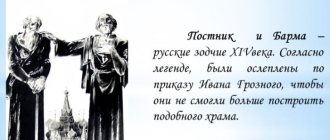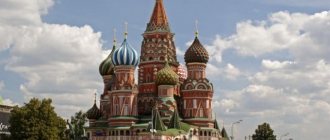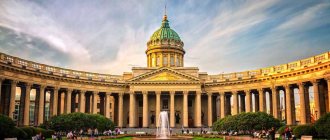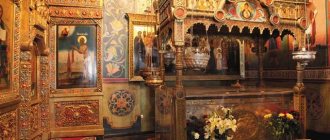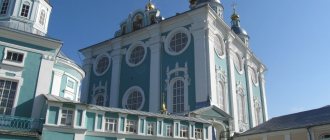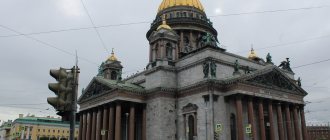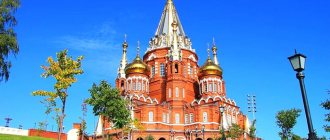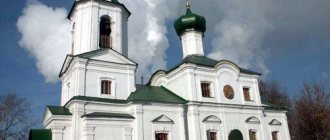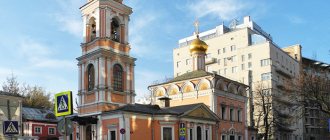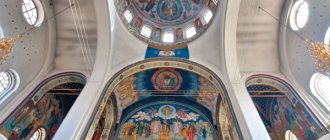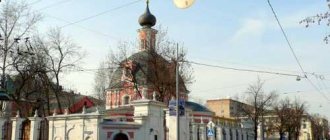Address:
Russia, Moscow, Red Square.
Working hours:
08.11.-30.04 from 11:00 to 17:00.
01.05.-31.05 from 11:00 to 18:00.
01.06.-24.08 from 10:00 to 19:00, except Wednesday.
25.08.-03.09 from 10:00 to 16:00, except Wednesday.
04.09.-07.11. from 11:00 to 18:00.
Services are held every Sunday, as well as on the second day of Easter. Starts at 10:00.
Ticket price:
entrance – from 150 RUB.
St. Basil's Cathedral, or the Cathedral of the Intercession of the Blessed Virgin Mary on the Moat, is one of the most beautiful and recognizable architectural monuments of Moscow, strongly associated with Russian culture throughout the world. Legends say that the creators of the beautiful temple were deprived of their sight by order of Ivan the Terrible; in the difficult post-revolutionary years, Stalin himself did not allow the building to be demolished, and during the Great Patriotic War the cathedral was reliably hidden from shelling.
Second name of the cathedral and location
Despite the established and widespread mention of the temple, its full name is the Cathedral of the Intercession of the Most Holy Theotokos, which is on the moat. This ditch was part of the Kremlin wall as its fortification.
The cathedral is located near transport routes. It is convenient to get to it from the Teatralnaya and Okhotny Ryad metro stations via Manezhnaya Square. From there, the view is blocked by the Historical Museum, but if you go around it, the Intercession Cathedral will be located on the opposite side of the square.
You can also get there using other transport, since there are bus routes and trolleybus lines in the area. The most convenient way to get there is by bus to the stop "Red Square" or "Teatralnaya Square", or by trolleybus - "Metro Kitay-Gorod", the so-called Slavyanskaya Square.
Description of appearance
The temple on Red Square in Moscow is an example of Russian architecture. When viewed from above, it is a strict geometric composition consisting of two squares of different sizes. Their arrangement at an angle to each other makes up a “custody” - the figure of an eight-pointed star.
Each corner of the star forms one of the 8 temples, and in the center is the 9th and main church. Such a number of thrones and such an idea have a deep meaning in Orthodoxy: the number 8 itself is quite symbolic, it marks the Resurrection of Christ, and the custodia is an ancient symbol of the Mother of God.
The 4 sides of the square are at the same time the cross, and universality, and the 4 Gospels. The 9th, central dome, in turn symbolizes the unification and patronage of the Mother of God over Russia.
Inside, all the churches are united by one common foundation, an internal gallery and vaulted passages. The temple is skillfully decorated with paintings, various ornaments and designs, but the outside was not always so colorful and bright. Colorful domes and iridescent tents were added later, after construction, and the interior ornaments of each church are different.
The height of the temple is 65 m; for a long time it was the tallest building in Moscow.
The temple does not have a main entrance; each of its sides can be considered a façade. Later, another St. Basil's chapel and a bell tower were added to the main structure.
The number of domes also changed over time. Initially, there were 25 large and small domes over the temple, then their number was reduced to 10: each over its own temple, over the bell tower and an additional chapel. Onion-shaped domes are individual and not repeated.
Architecture
Initially, the appearance of the complex was distinguished by masculine austerity; a plurality of elements prevailed here, among which it was impossible to single out the main one. The interiors had little space compared to the large and rich facades. The creators tried to assign a greater role to decorative elements.
Bell tower of St. Basil's Cathedral
The walls of the cathedral were made of bricks, and the bases, plinths and some supporting parts were made of white stone. Holes were made in the brickwork into which wire was inserted to connect two bricks. Using this technique, a stable horizontal surface was created over the span.
The unique and tall cathedral does not have a deep foundation; construction was carried out using a high basement on the hill. Eight aisles have onion-shaped domes. They are grouped around the main Church of the Intercession. Attached to the chapel, consecrated in honor of St. Basil, is the Church of the Nativity of the Mother of God, where the body of John of Moscow was buried at the end of the 16th century. The main buildings have a common base, as well as a bypass gallery and internal passages.
Interesting! St. Basil's Cathedral was added to the ensemble in 1588 above the burial place of the holy fool. The order for the construction was issued by the son of Ivan the Terrible - Fyodor Ioannovich.
The aisle is cubic in shape, topped with a traditional light drum, and the floor of the church is lined with cast iron slabs. Scenes from the life of St. Basil are visible on the walls of the interior. A decorative arch was installed above the burial of the saint, which is considered an extremely revered shrine.
History of creation
Ivan the Terrible's campaign of conquest to capture Kazan was coming to an end. The decisive battle ended the history of the existence of the separate Kazan Khanate, forever subjugating it and making it part of the Russian state. On October 1, 1552, the final assault on Kazan began; it became a decisive battle and led to the complete defeat of the Kazan defenders.
It was on October 1 that the Day of the Intercession of the Virgin Mary was celebrated, and therefore a large stone church was founded in honor of this holiday. Each of the existing aisles of the new temple was at one time a camp wooden church.
These churches were consecrated in honor of those holidays and days of remembrance of saints, the celebration of which marked significant victories on the way to the capture of the city. All these camp churches were united in the large Intercession Cathedral.
The history of its creation is surrounded by many legends. One of them talks about the master Postnik Yakovlev, nicknamed Barma. The second legend is that this is not one master, but two architects. According to legend, these craftsmen were blinded upon completion of the construction work so that they could no longer create anything so perfect.
This legend is quite common, but does not have much evidence. According to another version, the architect was imprisoned for boasting that he could create an even better church.
Another legend says that next to the old church there was the holy fool revered by Muscovites, St. Basil the Blessed. He was perspicacious, healed people, predicted, acted as a fool, and was very revered among people. Vasily collected money for the construction of a new temple, and then handed it over to the king.
This version cannot be definitively confirmed or refuted, since there is no exact news about the time of St. Basil’s death: perhaps he died before the construction of the cathedral was planned.
History of construction
With the construction of the temple, Ivan the Terrible perpetuated the memory of the defeat of the Golden Horde. The construction of the building began 2 years after the capture of Kazan on the site where the Trinity Church stood and St. Basil the Blessed was buried, who was considered a man of God and a miracle worker; the Tsar himself had reverence for him. There is a myth that he asked for money to build the cathedral.
Vasily himself walked almost naked, and the locals loved him for his gentle character. Later, the son of Ivan the Terrible ordered to set aside a boundary where the remains of the holy fool were placed. The cathedral took five years to build.
There are several myths about who the creator of St. Basil's Cathedral is:
According to one legend, the author of the artistic design is Metropolitan Macarius, and the construction was carried out by the architects Barma and Postnik. According to another legend, the construction was supervised by a Pskov architect. According to the third myth, Ivan the Terrible asked the architect who built the temple whether he could build exactly such a structure. The king did not like the affirmative answer and he ordered the master to be blinded.
During its existence, the Pskov temple suffered from a fire in the mid-16th century and the invasion of Napoleonic army in 1812. Napoleon liked the cathedral so much that he wanted to move the building to Paris, but such technology did not exist. Then gunpowder was placed in the building, but people began to pray for salvation, which came in the form of pouring rain.
Must read: Church of St. Gregory of Neocaesarea on Polyanka
The cathedral miraculously survived the October Revolution, only a few shells hit the walls of the building. The persecution of religion and the destruction of churches did not affect the Cathedral of the Intercession of the Blessed Virgin Mary; it was included in the list of monuments of cultural significance.
Dear brothers and sisters! We invite you to visit the unique resource https://www.slovo-pomoshi.ru/. With its help, you can convey your aspirations to St. Petersburg churches, chapels, monasteries, and also contact the righteous at the place of their burial. We will write a note ourselves, take it to the temple and send you a photo report by email. Turning to God with the help of prayers has helped many people overcome grief, regain health and the joy of worldly life.
Useful articles:
How to pray to the Guardian Angel Wise teachings of the elder - Schiamandrite Iannikias While still in bed, in the morning, call and pray to the Guardian Angel: 50 times “Holy Angel of God, my guardian, pray to God for me.” At ten: Holy Angel of God, my guardian, instruct and enlighten me.” On this day, a bad person is... Read more
TIPS - FRIENDS. HOW TO SAVE YOUR FAMILY. Hegumen Georgy (Shestun) A man should know: IT IS IMPOSSIBLE TO HUMILIATE and insult your wife by CALLING her rude words. Harsh words - WILL BE REMEMBERED, will land - A wound on the heart and will be expelled from there - Love. A man DOES NOT HAVE the right - TO COMMAND, to shout, to offend, and TO SUBMIT BY FORCE, by violence - his wife to himself. A man... Read more
Parable. When the Lord commands... A poor woman from a small family was very religious. And one day, when there was not enough money even to feed the children, she called the radio station and left there an appeal to God for help. While the radio employees treated the believing woman with understanding... Read more
A Story About One Family, a Dog, and About How Difficult It Is to Find a Decent Wife Everything was going well for me, I got a wife just to envy, three children of the same age were a joy, the business was developing at such a pace that it was possible to live from it, and attention I didn’t attract too much to myself... At first I didn’t even believe it, then I got used to it and thought that it would always be like this. And for two... Read more
The temple was given the status of the State Historical Museum, the vaults were removed from it and worship was prohibited in St. Basil's Cathedral. In the post-Soviet period, the cathedral came under the general management of the Orthodox Church of Russia and the historical museum.
Stages of construction work
The construction of the church lasted 6 years, from 1555 to 1561.
This time can be divided into several stages:
- 1588 - Tsar Fyodor Ivanovich established a holiday in honor of the revered St. Basil and in the same year, convinced of many miracles, he ordered the construction of a stone temple over the saint’s shrine. It became the 9th addition to the church.
- The end of the 16th century - the exact date of the fire is unknown, but after it the cathedral was partially transformed. Instead of a flat roof and a single dome, the church now had onion domes, and a bell tower was built on the territory.
- 1672 – miraculous discovery of the relics of St. John the Blessed. This event led to the addition of the cathedral.
- 2nd half of the 17th century – the appearance of the cathedral changes. Wooden arches and porch are replaced with brick roofing and pillars. The Church of the Virgin Theodosia is being built over the main entrance, creating an upper tier.
- 1683 g. – the belfry is being rebuilt. Now it is a 2-story building with an open area.
Cathedral style
The current appearance of the cathedral is very different from the early structure, which had white walls painted to resemble bricks; later, plant paintings appeared. The structure represents a unique complex of a central tent and eight domes around it in eight cardinal directions.
According to the design, the cathedral consists of shapes in the form of squares that form a star with directions to the eight parts of the world, as a symbol of the Blessed Virgin Mary. Sign eight has a symbolic meaning of the resurrection of the Savior. The structure was erected from bricks that were modern at that time. The decoration details, base and base were made of white brick, and the roof was decorated with polychrome tiles and kokoshniks.
One of the distinctive features of the cathedral is the connection of the building with a common base and a gallery. The style combines European and Russian architecture of the Renaissance period. Distinctive features include arched openings, the structure has solid walls and no basement. The northern part of the building's vault does not have any pillars for support.
In the 17th century the building was rebuilt and decorated in different colors. Painting with frescoes on domes and pillars appeared. This is the view that visitors can see today.
The domes of St. Basil's Cathedral are onion-shaped, and the central structure ends with a cone. All chapters differ from each other in color and texture.
We invite you to read: Prayer for the Nativity of Christ in Russian
Improvements and changes
The temple on Red Square in Moscow did not immediately have its original appearance, but was modified several times. After the main construction it was constantly improved. According to the architects, the cathedral was completely white and built of white stone blocks, but this changed in the 17th century. Instead of white walls there are ornamental paintings.
Instead of a golden dome covering - decorative processing in its modern form. The complete solution to the color of the domes is not completely known. There are only assumptions that are based on the legend about Andrei the Fool, who is associated with the Feast of the Intercession of the Mother of God. In his dream he saw Heavenly Jerusalem in the form of a blooming garden.
Gradually all the details of the cathedral were improved without drastic changes in architecture. Wooden, unreliable tented buildings were replaced with stone ones, and the domes were made entirely of metal. Altars from the dismantled churches were moved to the basement of the cathedral, underground for safekeeping.
Thrones from churches “on the blood”, which were located on old places of public executions, were kept there. According to various sources, there were from 13 to 20 such thrones. At the same time, several thrones were transferred from burnt Moscow churches.
Several chapels are also renamed: at the request of a wealthy depositor, the Church of Cyprian and Justina is renamed the Church of her patron saints Adrian and Natalia, and the Church of the Three Patriarchs of Constantinople is now named in honor of the Patriarch of Alexandria John the Merciful.
These names will be fixed until the 20th century. Also, the iconostasis from the Kremlin church was transferred to the Church of the Intercession. A grass ornament is being added to the parapets and the interior decoration of the galleries and, in general, the cathedral is almost completing all restoration work.
The Trinity fire in 1737 almost completely destroyed the interior of the cathedral. Its restoration took a long time, since all of Moscow suffered then. Particular attention was paid to restoration in the period 1784-1786. At this time, the appearance of the cathedral was changed: the built-on Theodosius Church was dismantled.
St. Basil's Cathedral in Moscow
St. Basil's Cathedral in Moscow
Contents
Intercession Cathedral or St. Basil's Cathedral in Moscow - located on Red Square, is one of the most beautiful and unusual architectural historical monuments of Russia in the mid-16th century. The Intercession Cathedral is part of the State Historical Museum of Moscow. In 1990, these architectural sites were included in the UNESCO World Heritage List.
For many years I admired the beauty and splendor of the Intercession Cathedral from the outside, passing by, and only recently looked inside. I was simply delighted with the interior decoration and originality of this building, built several centuries ago. The museum of St. Basil's Cathedral presents a lot of information in the form of plaques on the walls of the premises, on which it is briefly written about the building itself, its origin and periods of construction, about the saints in whose honor the cathedral churches are named.
To visit the museum, you can buy a comprehensive ticket with an audio guide, but for it you need to pay a cash deposit of 1000 rubles. In the Central Church of the Intercession of the Blessed Virgin Mary, I heard the magnificent singing of a male group, the echoes of their consonant voices echoed throughout all corners of the cathedral. Here the band sells CDs with recordings of their concerts; if you wish, you can purchase them.
A brief history of the emergence of St. Basil's Cathedral in Moscow
The temple was built in 1555-1561 in memory of the victory over the Kazan Khanate by order of Ivan IV the Terrible. Until 1588, the temple consisted of nine pillar-shaped churches located on one foundation (common to all individual churches). Each church is consecrated in honor of the holidays that fall during the decisive battles for Kazan. The main central church, whose height is 65 meters, is consecrated in honor of the Intercession of the Blessed Virgin Mary.
Around the main church there are eight smaller churches topped with onion domes. All these churches are united by two galleries. The builders of the temple were Postnik Yakovlev from Pskov and the architect Barma.
Beginning in 1588, the appearance of the temple began to change. Over the burial of St. Basil, after his canonization, another church was built below - the tenth, and in 1672 - the eleventh, over the grave of John of Moscow. In 1670, a tented bell tower was erected on the site of the old one; 11 years later, porches with tents were added, and the outer gallery was covered with brick vaults. A century later, during the reign of Catherine the Great (1780-1784), the first major renovation of St. Basil's Cathedral was carried out: the brick floors were replaced with white stone ones, paintings appeared in the churches, and the domes became multi-colored.
St. Basil's Cathedral in Moscow has been rebuilt several times throughout its history, restored after fires and looting, reconstructed and restored. The last restoration took place between 2001 and 2011. After which the permanent exhibition of the museum was placed here.
The museum contains a large collection of ancient Russian icon painting and objects of church and applied art, reflecting the four-century history of the cathedral. Downstairs (in the basement) everything is dedicated to the history of the construction and further development of the temple; in a separate room there are exhibits from the time of the first restorations; plaques with information about the different historical periods of the creation of the cathedral are attached to the walls. At the top (on the second tier) there are nine churches with unique interior items and icons of saints; On the walls of the gallery, artistic paintings created by painters of that time have been preserved.
The names of all 11 churches of St. Basil's Cathedral:
Church of Alexander Svirsky; Church of Varlaam Khutynsky; Church of the Entry of the Lord into Jerusalem; Church of Gregory of Armenia; Church of Cyprian and Justina; Church of the Holy Trinity; Church of St. Nicholas Velikoretsky; Church of the Three Patriarchs - Patriarchs of Constantinople: Alexander, John and Paul the New; Central Church of the Intercession of the Blessed Virgin Mary; Church of St. John the Blessed; St. Basil's Church.
St. Basil's Cathedral is the second name of the Intercession Cathedral in Moscow, which it received almost a hundred years after the burial of St. Basil the Blessed there.
Opening hours of the museum in St. Basil's Cathedral and ticket prices
The museum in the Intercession Cathedral is open daily from 11:00 to 17:00; in the summer months - 10:00 - 18:00. In winter, when temperatures are below -15C, the museum is closed to the public.
The cost of the entrance ticket for citizens of the Russian Federation and the EAEU is 500 rubles; pensioners and students (full-time education) - 150 rubles; family ticket (two parents + two children under 16 years old) - 600 rubles. Complex ticket: entrance ticket + audio guide in Russian - 800 rubles; in a foreign language - 1200 rubles. To receive an audio guide, you need to make a deposit of 1000 rubles.
Tickets are sold at the box office and on the State Historical Museum website; purchase of discounted tickets for citizens of the Russian Federation and the EAEU - only at the museum box office. Payment is possible both in cash and by credit cards.
The Intercession Cathedral also hosts services, art festivals, exhibitions, and creative competitions. Museum staff conduct lectures for anyone interested in Russian history. The cost of a ticket to the lecture is 350 rubles; discount ticket - 100 rubles; free - for children under 16 years of age and citizens of other preferential categories.
The entrance to the cathedral is opposite the ticket offices, located to the left of the central porch. At the entrance, directly in the basement, there is the Church of St. Basil, in which a reliquary decorated with precious stones is installed above the burial of the Saint (those who wish can venerate the relics). Before going up to the second tier, be sure to inspect all the rooms in the basement, since the exit from there will be on the other side - through the main porch of the temple. There are souvenir shops at the entrance and exit.
When visiting the halls of the Intercession Cathedral, free video and photography without a flash or tripod is allowed.
How to get to St. Basil's Cathedral
Metro station: Revolution Square, Okhotny Ryad metro station, Teatralnaya metro station Address: Moscow, Red Square, 7. Official website of the State Historical Museum: https://shm.ru/
Beginning of XX century
The war with France and Napoleon in 1812 almost led to the destruction of the temple. Soldiers kept horses in it, and according to one legend, they wanted to blow up the temple, and only divine intervention in the form of rain stopped it. Despite this, the cathedral was now in a deplorable state. It was looted and damaged by explosions from neighboring buildings.
After the end of the war, restoration of the square began, but the temple itself had not yet been restored in all its splendor: then only the fence and supporting wall were corrected. In 1880, the temple acquired an estate, and until 1918 its last rector, Fr. John (Vostorgov). In the 1880s large-scale reconstruction of the temple began. The sacristy was decorated with stained glass windows, and the floors were reinforced.
A special Commission was convened to renew and restore the cathedral in its original form. But the approaching October Revolution, its consequences, and lack of funds did not allow this to happen.
Restoration work in the mid-twentieth century
The temple on Red Square in Moscow became perhaps the first building that came under the protection and provision of the state. It was recognized as a world monument. Now the process of museumification has begun here - turning the temple into a museum display object. Services were officially terminated.
For the temple to fully transform into a museum, it needed to be completely restored, since the long years of revolution and devastation made it impossible to take care of the temple and led to its serious damage.
Its windows were broken and the roof was damaged, and in winter, some of the chapels of the temple were covered with snow and froze, not even allowing the doors to be opened. In the 1920s The cathedral was extensively renovated, and in 1923 its status was changed: it was recognized as a historical and architectural museum. Since that time, it has been constantly open to the public and closed only once, during the Great Patriotic War.
The cathedral was actively studied: for example, underground tunnels leading to the Kremlin and walled-up rooms were discovered in it. Additionally, it was discovered that the lower level of the temple was equipped with loophole windows. During the renovation process, these loopholes were covered with brickwork, which complicated the work.
The discovery developed the theory that the cathedral was equipped with cannons and, if necessary, battle could be fought from there. Then it became known that the lower basements were used as treasury storage and were equipped with doors, of which only hinges remained.
In 1929, the last liturgy was held in the Intercession Cathedral, after which the bells were removed and church services were finally banned.
The year 1930 almost became decisive for the ancient cathedral: Lazar Kaganovich presented Joseph Stalin with a model of the renewed city and square.
When he swept away the model of the cathedral from the model, proposing to remove it, Stalin said the legendary phrase: “Lazarus, put it in its place,” which saved the architectural relic from demolition. However, in 1936 a new threat of demolition loomed. Compared to the new city layout, it was located inconveniently and blocked part of the highway.
Restorer Pyotr Baranovsky refused to participate in the demolition of an ancient and important structure, and said in a telegram that he would blow himself up along with the temple, and after his arrest he was convinced to continue the work by the fact that the temple had already been blown up. If you believe the legend, then immediately after his release, after six months of imprisonment, he hurried to the Kremlin to make sure that the cathedral was not in danger.
The current status of the cathedral and how it has changed
Today, the right to use the cathedral is shared between the Russian Orthodox Church and the State Historical Museum. Church services are held there on Sundays, and to visit the temple as a museum object, you need to know the opening hours of St. Basil's Cathedral.
Throughout its long history, the temple was used for various purposes.
In addition to its main function - holding divine services - the cathedral also served as a storage facility: it housed the royal treasury and the property of privileged citizens. The wealth was hidden in the lower utility rooms.
In 1923, church services ceased to be held in the cathedral, and it received the status of a branch of the state historical museum, which it still retains. Also, it was since Soviet times that St. Basil's Cathedral was recognized as a national historical monument under state protection. Its archives contain ancient church books (both handwritten and printed).
And since 1991, when the Soviet system fell, services were resumed in the temple, which continue to this day.
Completion of restoration
The cathedral stopped being restored during the Great Patriotic War, but after its completion it opened in record time. Already on September 7, 1947, on the day of the celebration of the 800th anniversary of Moscow, the temple was opened at a gala event during a mass celebration on Red Square.
A few years later, a complete restoration of the interior walls began. A detailed study made it possible to discover real paintings from the time of construction. The cathedral began to be restored to its true appearance, and then the exact date of construction was discovered: July 12, 1561. In the 1960s. The cathedral's domes were covered, replacing the metal with wear-resistant copper.
It did not require regular replacements and renovations; then the domes were repainted and returned to their familiar modern appearance. The discovery of original frescoes made it possible to recreate the original paintings in the internal temples and on several external fragments.
In 1990, the cathedral was added to the UNESCO World Heritage List.
Under him, the largest collection of 19 bells was opened. In the same year, the right to share the cathedral between the State Historical Museum and the Russian Orthodox Church was approved.
New restoration work began in 2001 and lasted for almost a decade. This is the largest and most complete restoration in the entire history of the cathedral. All ten churches were renovated, the main shrine of the cathedral, the icon of the Intercession, was restored. The lower tier and basements were also renovated. At the moment, the cathedral ranks 5th in the list of “7 Wonders of Russia”.
Architectural features
St. Basil's Cathedral has a lot of architectural features, because its layout is not typical for buildings of the 16th century. Many foreign guests of the Russian Kingdom, as Russia was called during the reign of Ivan the Terrible, were amazed at its architecture.
The first feature is that the cathedral does not have a façade. This speaks of its versatility, from whichever side you approach, a grand view opens up and it seems that this is the main entrance.
The second feature is the fact that the cathedral has no basements, unlike other churches and cathedrals of that time. Instead, it has a basement with very strong walls 3 meters thick.
Another feature is the nine churches, which are united by one base, a roundabout gallery and internal passages with a vaulted ceiling. The gallery is decorated with fanciful ornaments depicting vegetation, which are also uncharacteristic of that time.
Churches
They are named in honor of the holy holidays that fell on the decisive days of the battle for Kazan:
- The central church is Pokrovskaya.
- Eastern Church - Trinity.
- South-Eastern Church - Alexander Svirsky.
- Southern Church - St. Nicholas the Wonderworker.
- Southwestern Church - Varlaam Khutynsky.
- Western Church - The Entry of the Lord into Jerusalem.
- Northwestern Church - St. Gregory of Armenia.
- North Church - St. Adrian and Natalia.
- Northeastern Church - St. John the Merciful.
It is surprising that the architects managed to combine the traditions of Russian and Western European art of the Renaissance, which gives the cathedral a unique look.
Domes
St. Basil's Cathedral has 10 domes of extraordinary beauty that you will not find anywhere else. Each dome is unique and completely different from the others. Combinations of blue, white, yellow, green, red and gold create a certain solemn atmosphere. And the unique shapes attract the eye, and it’s impossible to look away! True, the domes did not always look this way. The cathedral was repeatedly subjected to fires, and each time their appearance changed. They were upholstered in German iron and had a dark green color. The first tiles appeared later, and the color acquired only in the 1780s. After restoration 1967-1969. fragile iron was replaced with durable copper.
***
St. Basil's Cathedral is not just a cathedral on the main square of the country. This is a unique cultural heritage that we need to preserve. It’s not for nothing that it was classified as a UNESCO World Heritage Site. The museum is rich in paintings and ancient icons, and the decor of the cathedral and its architecture are so unique that the cathedral is recognized all over the world!
Operating mode
You can get to the cathedral almost every day on guided tours or just like that, by paying an entrance fee. Days off are the last Monday and first Wednesday of the month, as well as every Tuesday. During the summer, a sanitary day off is added every Wednesday. Visiting time may be reduced at temperatures from -15 and during certain events on Red Square.
The temple's opening hours vary depending on the season:
| Summer time (June 1 – August 24) | 10:00 – 19:00 |
| August 25 – September 3 | 10:00 – 16:00 |
| Autumn time (September 4 – November 6) | 11:00 – 18:00 |
| Winter time (November 7 – April 30) | 11:00 – 17:00 |
| 28 January | 11:00 – 18:00 |
| May (May 1 – May 31) | 11:00 – 18:00 |
1 hour before the closing of the temple, tourists are no longer allowed into the cathedral territory, and the ticket office closes half an hour before closing.
How much does a ticket to the cathedral cost?
Like the opening hours of St. Basil's Cathedral, the price for visiting it also varies, but it depends not on the time of year, but on age. Adults must pay 500 rubles for the right to see the inside of the temple. For teenagers from 16 to 18 years old the cost is lower - only 150 rubles. And children under 16 years of age are admitted free of charge.
In addition, preferential categories of citizens (full-time students, pensioners, etc.) can count on a discount if they have a document confirming their status.
Also keep in mind that there is a separate fee for excursions, which is not included in the entrance ticket price.
About an hour before the museum closes, the ticket office stops working and no longer allows new visitors into the building.
Surely, after getting acquainted with the history and time of operation of St. Basil's Cathedral, many people had a desire to see this majestic architectural monument with their own eyes. We wish you to definitely implement it!
Conducting religious services
The Church on Red Square in Moscow is a museum and an architectural monument, therefore permanent services are prohibited there, except for the Liturgy and the subsequent akathist to Blessed Basil in his chapel. The Liturgy begins at 10:00.
An additional service is held on Bright Tuesday after Easter. Services for patronal feasts are also held in each chapel.
"Vitality" of the Cathedral
Several times the temple was at risk of being destroyed.
The temple was severely damaged by a fire in 1737, after which the building underwent major reconstruction.
The first deliberate attempt to destroy the cathedral was made by Napoleon Bonaparte, who located his stables on its territory. Leaving Moscow, he gave the order to burn the building. However, a sudden rainfall prevented these plans, extinguishing the already lit cannon fuses.
During the period of Soviet power, the temple could also disappear from the face of the earth and the map of Moscow. In the 30s, the architectural modernization of the capital was carried out, it was carried out under the leadership of Lazar Kaganovich. He wanted to demolish the temple to make way for additional space for military parades and demonstrations. Kaganovich presented Stalin with a model of Red Square, in which St. Basil's Cathedral was not there. However, the “father of nations” ordered the building to be returned.
Also, according to rumors, the architect Pyotr Baranovsky “stood up” for the temple, refusing to measure its area for subsequent demolition. For this he paid with several years in prison, but the goal was achieved - the cathedral remained standing on Red Square.
Excursions
The cathedral regularly hosts excursions of various directions. The cost of each type of excursion varies, but almost always in addition to them you will have to buy a separate ticket to enter the cathedral.
- Special excursions – special events. These include a specialist guide and visits to the cathedral at special times, such as an evening visit to hear a vocal ensemble perform. Such excursions are closed and are held at a certain time, subject to a minimum group. Special tours may take place 1 hour before or 1 hour after opening, but these tours also require a minimum group size. These excursions are suitable for those who want to get an unusual experience.
The Church on Red Square in Moscow (St. Basil's) has special excursions for children and master classes - Sightseeing tours - suitable for all ages, from elementary school students to high school students and adults. The cost of such excursions is lower than that of special ones, and the group is relatively small. During the excursion, you will be able to walk around the entire temple, learn a little about everything: history, painting, the location of the temple and the main historical milestones.
- Thematic excursions are dedicated either to a special event or to a specific topic. For example, excursions that focus exclusively on architecture, icons or painting. Such excursions are suitable for those who want to delve into a specific aspect of history and learn more about it.
The city of Moscow is the Third Rome. It is impossible to be there and not visit Red Square, and once in Red Square, not to visit the world-famous temple. This cathedral carries centuries of history and culture; it is a significant monument of ancient Russian architecture and a unique ensemble of 10 churches, called the “stone flower”.
Author: Volkova Katya
Article design: Mila Friedan
Cathedral builders
It is not known for certain who built St. Basil's Cathedral. There are several versions on this matter. One of the most popular says that the Cathedral was created through the efforts of Russian architects Ivan Barma and Postnik Yakovlev. Some sources claim that we are not talking about two, but about one person, whose name was Ivan Yakovlevich Barma, nicknamed Postnik.
There is a terrible legend that the tsar ordered, after the completion of the construction of the Intercession Cathedral, to blind its craftsmen so that they could not create a structure equal in beauty and grandeur. However, documentary sources refute this story. For example, Postnik Yakovlev is mentioned in later Kazan books as the builder of the Kazan Kremlin, and other architectural, mainly church, objects are also attributed to him.
Some researchers are inclined to believe that the Intercession Cathedral was built not by Russians, but by Western European, most likely Italian, masters. You can appreciate the beauty and splendor of the building during excursions around St. Basil's Cathedral, the opening hours of which will be discussed below.
